We have been working on a crew optimization tool for several years. This year we looked at the...
New feature finds hidden opportunities to reduce crew-related costs
The solution we developed generates recommendations for adjusting the flight schedule to decrease crew demand and cut crew-related costs.
We presented a new feature at the Agiforce Scheduling and Strategic planning Study Group meeting. Here's what we talked about
It happens that a slight adjustment of the flight departure time allows the airline to reduce the cost of crew positioning and accommodation, increases crew utilization, and minimizes the risk of delays due to the unavailability of crews.
Before we start, I would like to introduce our team and our work in Rosterize. It will help to understand better the context of our work.
Rosterize is an AI addon to any flight operations and crew management system that empower operators with AI-assisted crew planning.
The core product of Rosterize is a holistic model to plan aircrews and a little bit tails. We did not separate the crew planning into crew demand forecasting, pairing, rostering, and tracking products.
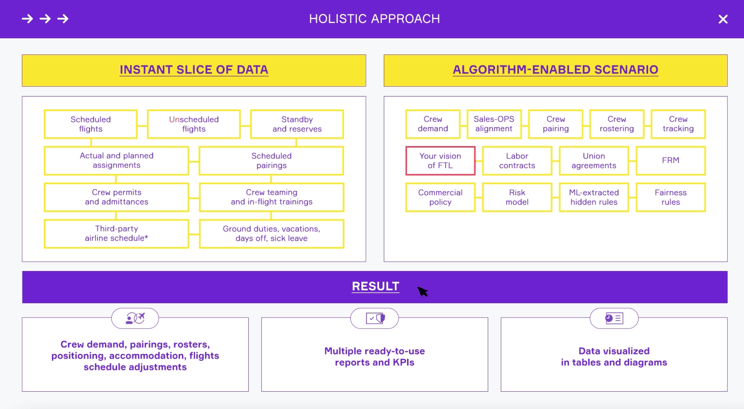 Avoiding the traditional siloed approach has its pros and cons. The main advantage is the ability to play with data that you are losing if you divide the planning process into even integrated but different pieces.
Avoiding the traditional siloed approach has its pros and cons. The main advantage is the ability to play with data that you are losing if you divide the planning process into even integrated but different pieces.
For example, our pairing is flyable from the beginning; they do not need to be manually adjusted during the rostering, or even more, you can use Rosterize as the precise and provable crew demand calculator – the number of crew sets can be verified by crew pairings that can be rostered with the calculated number of crew sets.
Our story started in 2019 when we were contacted by one regional charter and scheduled airline to help them with crew planning. And although our team already had years of experience in Operational Research, we did not deal with the aviation industry.
Our brief market research uncovered the absence of solutions for small and midsized airlines.
The main point is that, please, no offense, the well-known providers proudly work with the largest players and have no intention of providing optimization products and services adjusted for the smaller operators.
I am not talking only about product capabilities or license fees. Smaller operators need different business approaches. They cannot afford lengthy-lasting implementation; they cannot precisely determine the detailed business requirements. That is why we include all the system modifications in the subscription fee. This approach uncovered the potential for win-win cooperation between our customers and us. Crew planners do not think about the budget of the update, they share their issues, challenges, and ideas, and we jointly face them.
One day, we received two identical requests from the airlines operating in the opposite parts of the Globe. They asked us if we could provide recommendations on slightly shifting some flight departures to increase the efficiency.
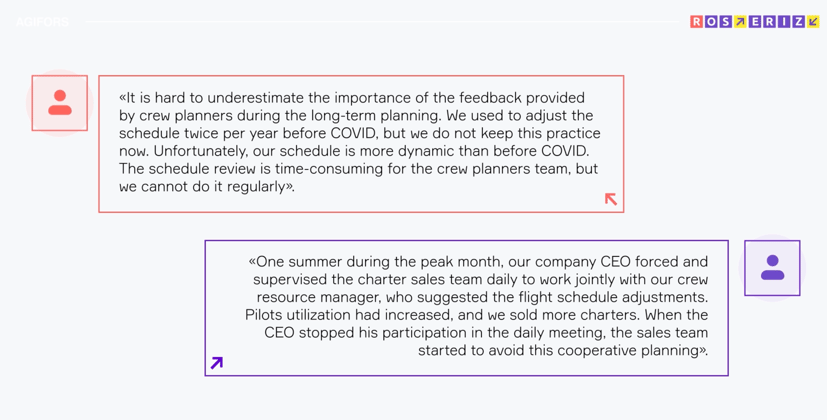
The first company wanted to decrease crew demand during the peak season. Another wanted to empower the charter sales team with a tool that would help them avoid extra crew positioning and accommodation during the quotation process.
After that, we asked a couple of dozens of crew planning professionals about their experiences, and we were shocked by the results.
Almost everybody shared that it is hard to overestimate the value of such feedback to the sales team, but their company does not use this opportunity regularly now.
And we also did not get any numbers regarding the impact of this feedback. A kind of top-secret, or nobody knows.
Let’s take a helicopter view of the overall planning process.
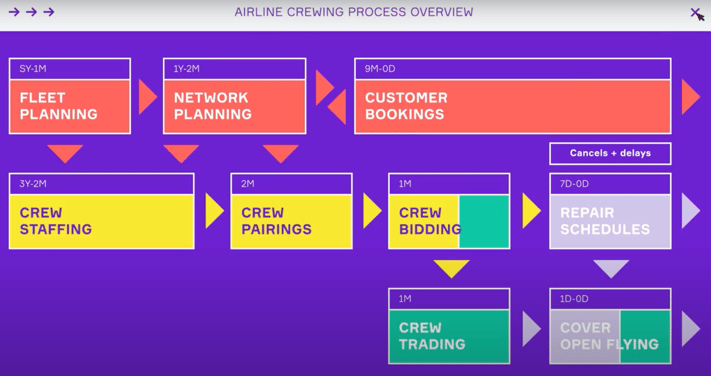
We can see that there is no tight collaboration between those in charge of crew planning and those in charge of schedule development. It is common for seasonal planning when crew planners are involved in the schedule design twice per year. But most of the time, the updated schedule is just provided to the crew planners; they are just informed.
When everything was stable, cooperative planning was carried out twice a year, and crew planners had time to cogitate and provide recommendations.
The new normal differs from the old one – it is dynamic and constantly changing.
More than ever, schedule changes are happening, and you must adjust it several times a month, or even a week, or even a day, or the updated schedule would be less optimal.
Sales must react immediately to succeed. Dynamic, ad-hoc rescheduling is a key to survival. In the perfect world, the optimal solution must be found in real-time. That is not how the crew schedules manually could work. We observed the real tragedy when a crew planner worked hard during a week with sales bidding for 5 thousand flight hours for the charter program and how he was devastated when they lost a deal.
Thus sales assume that crew will be found, and crew-related costs are just some amount multiplied by flight hours. As a result - some flights become unprofitable, some charter requests could be lost because of the overpriced offer, and sometimes it is not possible to fly because there is no crew for the flight.
So, it's time to talk about what kind of adjustments we propose.
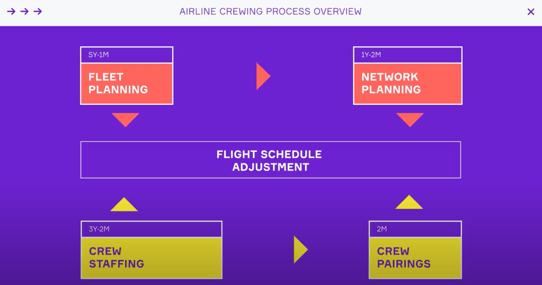 The core idea is to calculate the additional value of the potential flight adjustment.
The core idea is to calculate the additional value of the potential flight adjustment.
Because the system can do it automatically, it is not mandatory to involve crew schedulers every time. We can shift flights, consider many different options, and show the most exciting opportunities.
For example, airport slots cost and potential revenue depending on the departure time change could be considered. As a result, the flight scheduling process can simultaneously consider crew-related costs.
For this system to perform the best way, it is necessary to add additional data that people keep in mind. Luckily, the amount of this data is small and can be input iteratively education the system, like reinforcement learning. We launched the algorithm, saw if that gives nonsense, corrected the rules, and restarted.
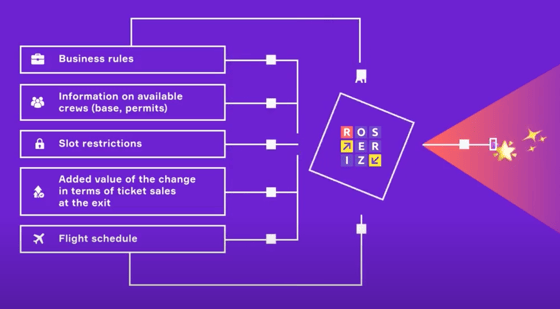
We have provided many options for business rules under which flights may or may not operate. If any new business rules are required, we can quickly add them. For example, the list of available departure slots and the price to use them, the flexibility of the airport, or even would it be possible for a regular flight to have departure times differ from day to day, from week to week.
The algorithm was able to design very clever schemes to improve efficiency. We can say that this is not just Artificial Intelligence trained on human behavior but cunning Intelligence searching for hidden opportunities.
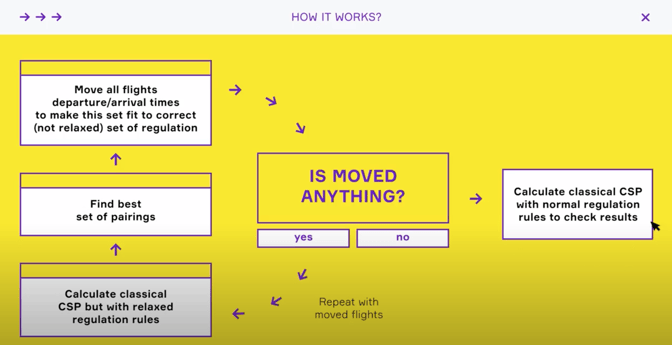
Of course, depending on the situation, we could change the target for the optimization. For example, it is more critical for peak season to decrease crew demand, and for the low season, it is better to focus on crew-related cost reduction.What ideas worked
- Move flight to change the maximum FDP duration
- Move flight to make possible rest between duties and remove layover with pax and additional crew set.
- Move order of flights to make a new variant of duties possible.
- Move flight into a cheaper time slot, without worsening the whole flight schedule.
You can make the time of the flight shorter by using a higher speed. You lose money but can significantly improve the flight schedule sometimes.
Let’s talk about the results:
One test based on the peak month schedule of operators with 30+ tails demonstrated a 10 percent decrease in the total crew demand. In the second test for a low season for a small operator with ten tails, the system avoided a half of crew positioning. The results were achieved assuming that it was possible to shift all flight departure times within two hours.
The current status, We have developed a prototype mode for our holistic crew schedule system. Completed several test calculations based on the real-life data available from our customers.
Because this feature is based on holistic crew planning, we can use it for any period, starting from the strategic planning and running on the operational level, which seems valuable for ad-hoc charter operations.
Is there something new? No, but the feature is quite rare.
We spent a lot of time searching for solutions that could provide such capabilities, and only the Jeppesen Crew Pairing “RETIMING” feature was found for the strategic planning. Several vendors shared confidently that such capabilities they have in their product development plan.
We would be grateful if you share information about other providers.
Meanwhile, we are looking for airlines, software providers, and consultancy firms, who would be interested in pilot projects, or ad-hoc one-time analyses.
It seems promising to cooperate with the revenue management system providers, as well
